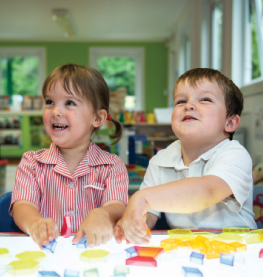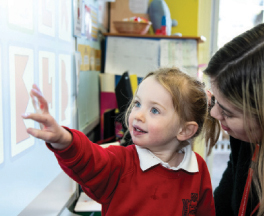
by Sam Selkirk
Head of Reigate St Mary’s Lower School
In the words of Einstein “Education is not the learning of facts, it’s rather the training of the mind to think.”
When do young children start to think? What do we know and how can we best support children from birth upwards?
I love the analogy of a child’s development in the context of a building, you start with the foundations and the quality of those foundations determines how stable and solid the building will eventually be. Thinking skills need to be part of those foundations; all too often the emphasis has been on developing thinking skills when children enter Key Stage 2, but one could argue that this is leaving it too late.
So, when do children start to think?
During the second half of the 20th Century there was an increase in research on brain development and the findings were summarised by Dryden and Vos in ‘The Learning Revolution’ that “Neural connections that don’t develop in the first five years of life may never develop at all.” We have a responsibility to provide opportunities to guarantee every child establishes ‘strong’ neural pathways, the direction we take should follow the research “We learn 10% of what we read, 15% of what we hear, but 80% of what we experience”.
Let’s further explore the significant elements through the research of two key players in the field of child development, Jean Piaget and Lev Vygotsky.
Piaget states that children learn by constructing schemas – patterns of repeatable behaviour which can be noticed when they play; by recognising these schemas and providing opportunities for them, we extend patterns of behaviour and thinking.
Furthermore, he suggests young children (birth to seven years – there are another two age ranges after this) move through two stages of cognitive development:
1. Sensorimotor: birth to 18-24 months when children focus on what they see and do, and physical interactions with their immediate environment. They are constantly experimenting and learning about the world through trial and error. During this period, their increased physical development leads to increased cognitive development. Then there is that important milestone – early language development.
2. Preoperational: 18-24 months to age 7 during which, children begin to represent objects with words and images, further develop language skills and imagination. Their thinking is based on intuition and still not completely logical.
Also we have Vygotsky whose theory of cognitive development focused on the role of culture and social interactions with speech being a major tool in the development of thinking.
To develop young children’s minds we must acknowledge:
• Every child is unique and goes through stages of development.
• We need to provide children with a rich and stimulating environment both inside and out where they are active participants in their learning and involved in a range of sensory experiences.
• The role of the adult is essential in developing positive relationships and to stimulate, support and encourage children.
 As Carol Dweck states: “Everyone is born with an intense drive to learn, infants stretch their skills daily. Not just ordinary skills, but the most difficult tasks of a lifetime, like learning to walk and talk. Babies don’t worry about making mistakes nor humiliating themselves. They never decide it’s too hard or not worth the effort. They walk, they fall, they get up. They just barge forward.”
As Carol Dweck states: “Everyone is born with an intense drive to learn, infants stretch their skills daily. Not just ordinary skills, but the most difficult tasks of a lifetime, like learning to walk and talk. Babies don’t worry about making mistakes nor humiliating themselves. They never decide it’s too hard or not worth the effort. They walk, they fall, they get up. They just barge forward.”
Through the Characteristics of Effective Learning (EYFS Framework) we can facilitate this; however, these are not an add on, they must infiltrate all aspects of a child’s life – be our ‘way of being’. Let’s explore these further…
Play and explore:
• Find out and explore – show curiosity using senses and interests.
• Play with what they know – representing their experiences in play, showing flexibility in their thoughts.
• Being willing to ‘have a go’ – taking risk, using trial and error – not fearful of making mistakes.
Be active learners:
• Being involved and concentrating – showing high levels of fascination.
• Keeping on trying – and then bouncing back after difficulties.
• Enjoying achieving what
they set out to do – intrinsically motivated to accomplish something.
Create and think critically:
• Having their own ideas – solving problems.
• Making links in their ideas – noticing patterns, making predictions, cause and effect, developing schemas.
• Choosing ways to do things – planning, checking how things are going, changing strategy if necessary, reviewing how well the activity went.
• Solve problems without adults suggesting what to do, or even worse, doing it for them!
And what else?
• Provide opportunities for play and develop the ‘stop, look, listen’ approach – we mustn’t interfere, just observe until the child invites us in.
• Ask open ended questions such as “What ideas do you have?” “What do you think is happening?” “Tell me why you think this?” “How would you solve this problem?” “What other ways can we try this?” “What other answers may there be and why?” Give them time to think before they answer – count to 10, at least, it feels like forever, but it is essential to allow the child to process their thoughts.
• Value and encourage children’s questions.
• Give children time to talk with each other but model that talk through open ended questions, reasoning and changing our minds.
• Talk more about the process rather than the end result using the language of learning, by modelling, scaffolding, making connections and embrace making mistakes – this will mean they will be more willing to take risks.
• Give children the independence to select activities and the opportunity to repeat.
• Give them the opportunity to plan, do and review, talking about what has worked well and what they would change.
And the environment?
• Accessible to the children, so they can self-select.
• Calm and uncluttered with a variety of toys related to the children’s interests: construction and small world toys, games, role-play areas from vets to restaurants, mark making materials, items to count, shapes, jigsaws, paint, items such as guttering, plastic tubing, boxes, natural resources, leaves and twigs.
And finally give children time to play inside and out, many a time I have observed children do something outside that they had yet to achieve inside, that sense of space for many young children is key.
And to conclude, heed the words of William Yeats “Education is not filling of a pail but the lighting of a fire.”
Reigate St Mary’s is a junior school of Reigate Grammar, situated within a beautiful 15 acre site close to the town centre. The school has been shortlisted for Independent Prep School of the Year 2020 in recognition of its all-round excellence and holistic approach to education. A growth mind-set celebrates hard work and effort not innate talent. In focusing on the journey and in embracing mistakes and failure as part of improving, children build the resilience and risk taking required to succeed. www.reigatestmarys.org











